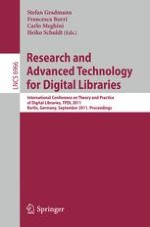This book constitutes the refereed proceedings of the International Conference on Theory and Practice of Digital Libraries, TPDL 2011 - formerly known as ECDL (European Conference on Research and Advanced Technology for Digital Libraries) - held in Berlin, Germany, in September 2011. The 27 full papers, 13 short papers, 9 posters and 9 demos presented in this volume were carefully reviewed and selected from 162 initial submissions. In addition the book contains the abstract of 2 keynote speeches and an appendix stating information on the doctoral consortium, as well as the panel, which were held at the conference. The papers are grouped in topical sections on networked information, semantics and interoperability, systems and architectures, text and multimedia retrieval, collaborative information spaces, DL applications and legal aspects, user interaction and information visualization, user studies, archives and repositories, europeana, and preservation.
